
It can be mind-boggling to think about how many hands a manuscript has passed through between the time that its pages were copied and gathered into a book and the time in which we now look at them, on the screen or in person. Corrections and additions offer tantalizing glimpses into the responses of early readers (see an earlier post on one such reader) or into the uses to which they put their books (see our most recent post). Sometimes earlier scholars’ labors over the manuscript come to light. And of course, the stories of a book’s movements through the libraries of different collectors can be absolutely fascinating.
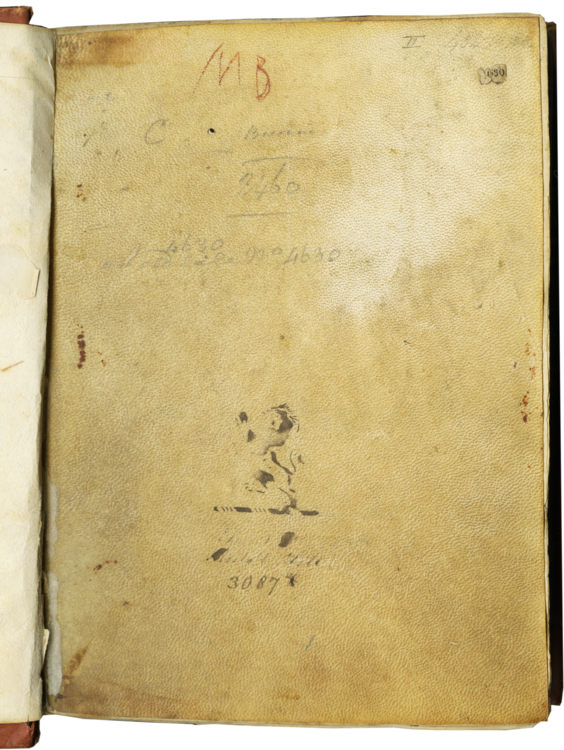
The inscriptions and marks on this manuscript flyleaf preserve traces, some identified and some still a mystery, of the earlier owners of this historical manuscript, an Italian translation of the Chronicon Pontificum et Imperatorum of Martinus Polonus, TM 117, f. ii recto, Northern Italy (Vicenza), dated 1472
If a book once belonged to a famous collector, I always wonder what human stories lie beyond the hard facts of auction catalogues and ownership marks – what in particular drew the collector to it? did he or she look at it? read it? what were his or her associations with the book?
When it comes to the great nineteenth-century British antiquary, book collector, and self-proclaimed “vello-maniac” Sir Thomas Phillipps, pictured below, we are fortunate not only to have a lot of hard facts to work with, but also to have access to his own words on the subject of his collecting and the bibliomania that drove it. Phillipps once wrote in jest (but not without a grain of sincerity, one suspects) that he wished “to have one copy of every Book in the World!!!!!”. Where medieval manuscripts are concerned, he came closer to reaching this goal than any private collector ever has, nearly bankrupting himself in the process. At the time of his death, he had a collection of over 60,000 manuscripts.
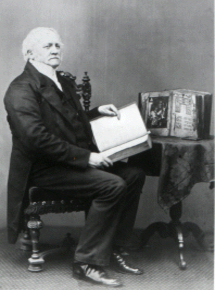
Photograph of Sir Thomas Phillipps, self-proclaimed “vello-maniac,” seated with two manuscripts from his enormous collection, 1860
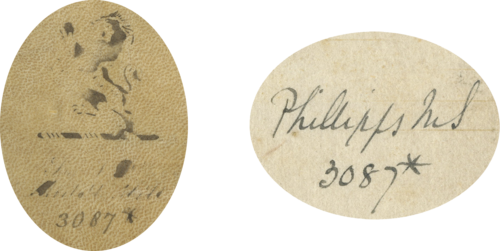
This stenciled crest appears in many of the manuscripts in the collection of Sir Thomas Phillipps, as does an accompanying inscription with the shelfmark Phillipps assigned to each of his manuscripts, TM 117, ff. ii recto (detail) and 1 (detail)
Because he acquired manuscripts in such quantity, one wonders how many of them passed into Phillipps’s library without ever receiving his close attention. That said, there is reason to believe that he did take an interest in the manuscript pictured above and below, our copy of Cronica degli pontifici e degli imperatori, a possibly unique Italian translation and continuation of an immensely popular thirteenth-century Latin chronicle.

The opening page of the Cronica degli pontifici e degli imperatori features a trace of one of its earliest owners in the coat of arms painted in its lower margin, TM 117, f. 9

Detail of an inscription added by a nineteenth-century hand, TM 117, f. 1
Accompanying the many marks of ownership at the opening of this manuscript, the inscription above not only dates to the long period in which Phillipps owned this manuscript, but also resembles specimens of his handwriting preserved in auction catalogues and correspondence. Phillipps himself may well have made this note in the front of the book.
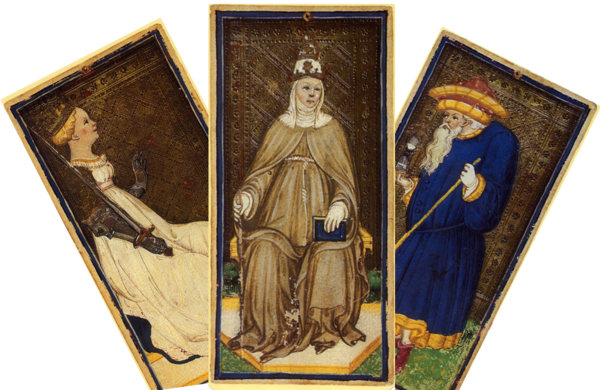
Possibly in reference to the legend of Pope Joan, the Popess featured in many early tarot decks, including the Visconti-Sforza tarot deck, drawn by Bonifacio Bembo, New York, Pierpont Morgan Library, inv. M. 630, c. 1450
In any event, the inscription is correct. Among the many sensational events that this chronicle recounts is an account, almost certainly fictitious, of Pope Joan, a woman who supposedly disguised herself as a man and was elected pope in the ninth century. In fact, this chronicle’s Latin source, the Chronicon pontificum et imperatorum of Martinus Polonus, furnishes one of the earliest and most popular accounts of this legend.
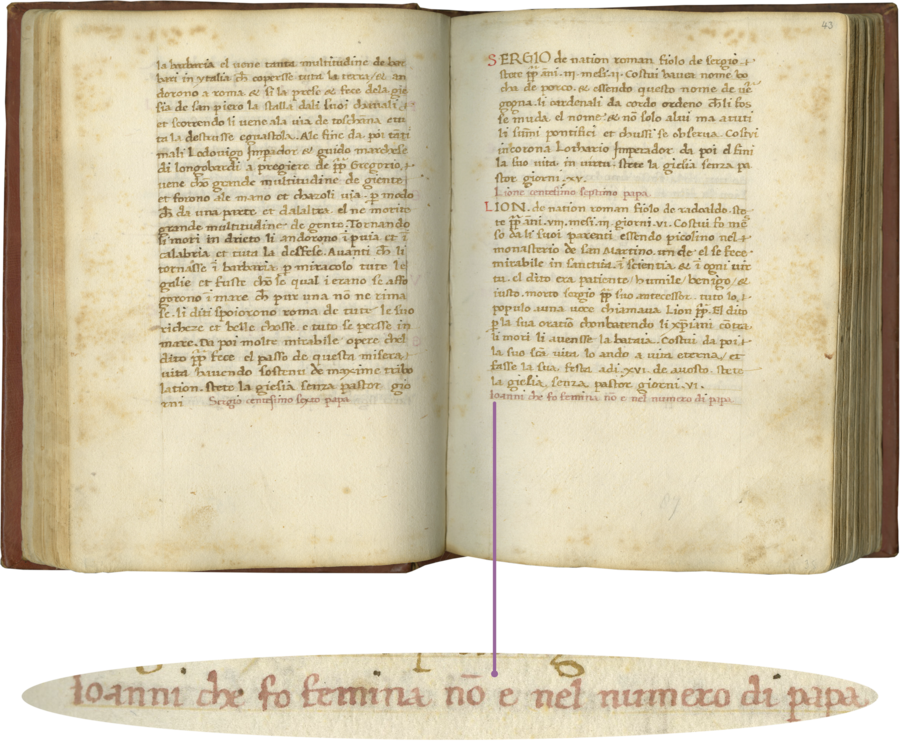
The Cronica’s account of Pope Joan’s reign begins here with the rubricated heading “Ioanni che fo femina non e nel numero di papa [John who was a woman and not numbered among the popes],” TM 117, f. 43 (detail)
As the chronicle has it, the woman who would become Pope Joan first dressed as a man in order to follow a lover. She would go on to receive an advanced education. After she became pope, her deception came to light in most dramatic fashion when she gave birth to a child in the midst of a papal procession.

Pope Joan giving birth in the midst of a papal procession, in a woodcut by Jacob Kallenberg from an edition of Giovanni Boccaccio’s De mulieribus claris, published in Bern, 1539
Why might Phillipps (or a contemporary) have remarked on this story in particular? It may simply be that this sensational tale was one of his readiest associations with Martinus’s chronicle. (It was also not included in every copy, so its presence here might have been considered noteworthy.)

Pope Joan, as depicted in a tinted woodcut from Hartmann Schedel’s Liber chronicarum, with woodcuts by Michael Wolgemut and Wilhelm Pleydenwurff, published in Nuremberg, 1493
But there is another possibility. By the nineteenth century, scholars had long discounted Pope Joan’s tale as legend. Still, it endured as grist for anti-Catholic polemic, where it was used to undermine the legitimacy of the papacy and paint Catholics as absurdly credulous. According to A. N. L. Munby, author of the definitive study on Phillipps’s life and collection, such was Phillipps’s own violent hatred of the religion and its practitioners that he feared a Catholic coup, was convinced that Jesuits were meddling with his mail, and, more to the point here, “delighted to discover in his library and publish to the world evidence of unchaste practices in nunneries or the more curious details of Papal elections.” The story of Pope Joan here may have provided him with an irresistable opportunity to indulge this habit, making the book even more appealing to this avid bibliophile.
You can now receive periodic blog post updates by submitting your email up above in “Follow Us.”


